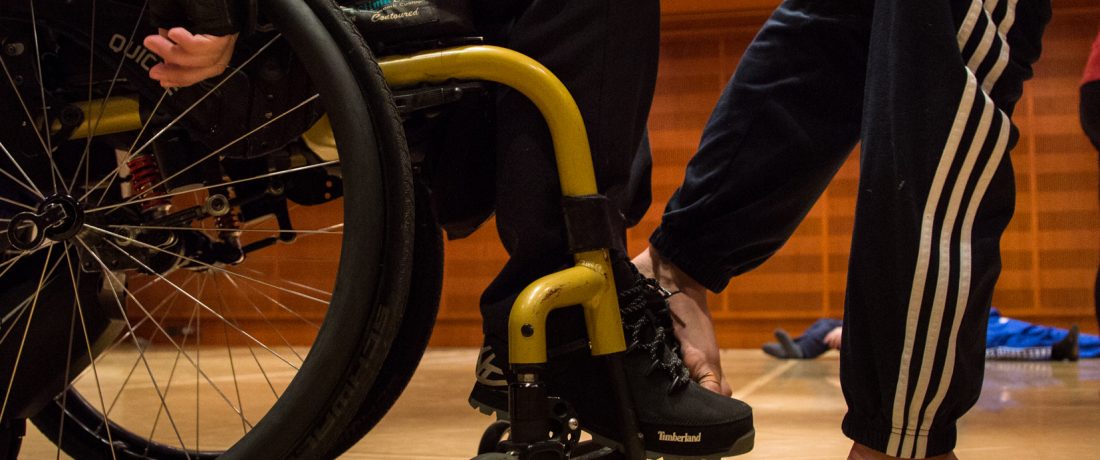
Exploring Body Awareness
TARGET GROUP
Professional and emerging Dancers with and without disabilitiesPARTICIPANTS
18-22DURATION
1.5 hoursORGANIZATION
Stopgap Dance CompanyGoal - Essential question
Class for professional and emerging dance artists exploring body awareness.
Check in (10 minutes)
Settle and focus: Notice how you are feeling today –how is your body? If you have any places of tension or stiffness try to send your breath into that place, imagine the breath filling the area and creating a bit of space every time you inhale.
Breathing together: Breathe in and imagine the breath travelling in a figure of eight. As your breathe-in, it travels up the front of the body, in through the chest and over the back of the head. As you breathe-out, it travels over and down the front of your head, in through the chest and down the back of the body.
Stretching with breath: Find different stretches, starting small and building up to whole body stretches matching up your breath with each stretch.
Outcome: Time to focus on your own body and mind.
Spine mobilization (15 minutes)
Build up a repetitive sequence for the spine working through the three different planes (see below). Start slow and allow individuals to work in their own time with space for focusing on what they need. Progress to moving a little faster with set counts.
Sagittal: A sequence of forward curves and roll-downs
Frontal: A sequence of different tilts and side curves
Transverse: A sequence of different twists
Outcome: Warming up the spine in its different plains.
Instruction game (10 minutes)
Start moving around the space, weaving in and out of each other. The leader calls out various instructions to which the dancers respond.
Examples:
Go – Move around the space.
Stop – Stop, sharp and instant.
Clear – Move to the sides of the room.
Swap – Try to travel in a line as straight as possible to the other side of the room.
Queue – Create a queue from one side to the other, making sure you are evenly spaced.
Person – Find a partner and leave no space between the two of you.
Centre – Huddle in the center of the room and then rest your head on someone else.
Outcomes: Cardio, increase focus and responding
Hand isolation/Brain warm up (10 minutes)
A short repetitive sequence that challenges brain and coordination.
Example: Four different hand shapes
1. Flat with fingers together (paper)
2. Flat with fingers spread (fan)
3. Fingers curled down (claw)
4. Fist clenched (rock)
Repeat this sequence to get it to flow naturally. Then, add a delay so your hands are at 2 different points in the sequence. Try to increase the speed.
Progression: Add different layers, for example – directions or facings for the hands, looking in different directions or transfers of weight.
Outcome: Brain- training, improve co-ordination.
Improvisation (10 minutes)
Improvise with a particular body part to travel you around the space. When instructed, find a partner, rub their skin (swap), continue the improvisation to journey to a new partner, tap (swap), continue the improvisation to journey to a new partner – squeeze (swap), journey and find way to the floor.
Outcome: Waking up skin to touch in prep for floor work.
Surface (10 minutes)
Create an exercise that uses the idea of yield and push into a surface (floor, wall or other available surface). Think about giving your weight into the surface through different parts of the body.
Outcome: Exploring pressure into the floor – yield and push.
Balance (10 minutes)
Create a controlled balance exercise that is done on a basic level first time around and repeated with opportunity to challenge your balance further.
Think about changing focus and controlled transfer of weight.
Outcome: Challenging own sense of balance.
Phrase (15 minutes)
Create a phrase that shifts in space using material, aspects and ideas from the exercises in the class.
Outcome: Reinforcing learnt material.
Cool down (5 minutes)
Repeat the spine mobilization from the start of the class. Bring attention back to breath. Find different stretching using breath to deepen the stretch.
